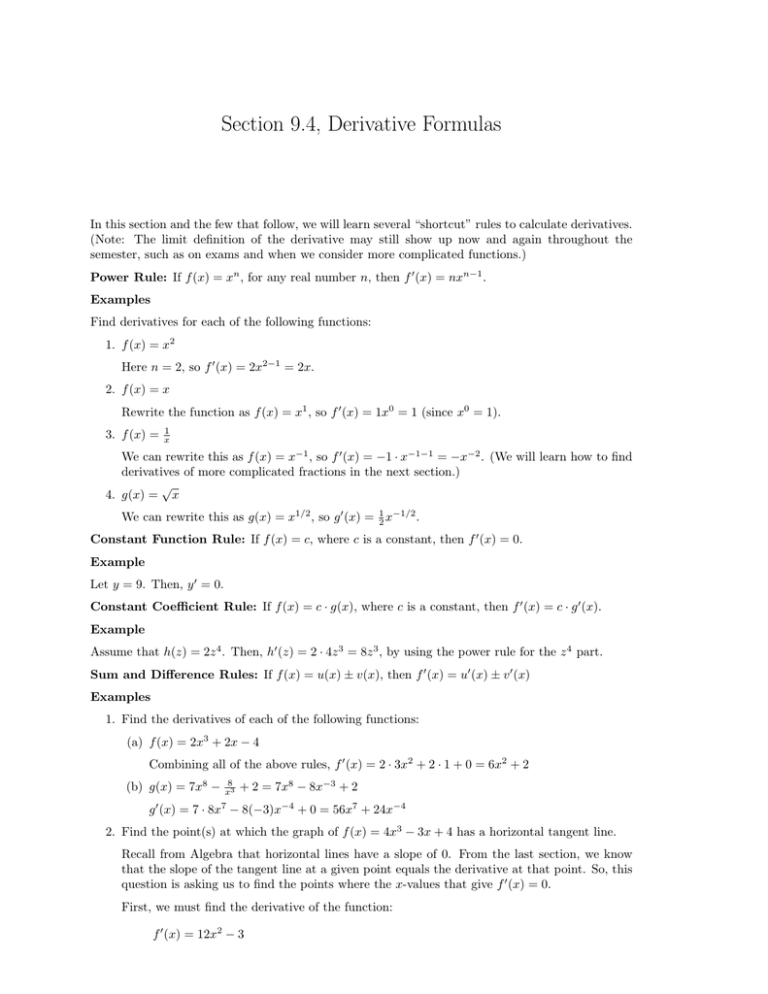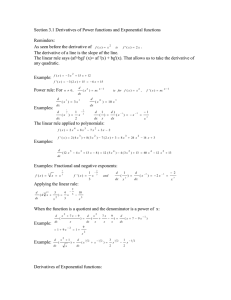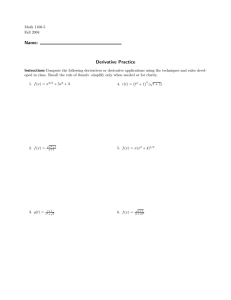Section 9.4, Derivative Formulas
advertisement

Section 9.4, Derivative Formulas In this section and the few that follow, we will learn several “shortcut” rules to calculate derivatives. (Note: The limit definition of the derivative may still show up now and again throughout the semester, such as on exams and when we consider more complicated functions.) Power Rule: If f (x) = xn , for any real number n, then f 0 (x) = nxn−1 . Examples Find derivatives for each of the following functions: 1. f (x) = x2 Here n = 2, so f 0 (x) = 2x2−1 = 2x. 2. f (x) = x Rewrite the function as f (x) = x1 , so f 0 (x) = 1x0 = 1 (since x0 = 1). 3. f (x) = 1 x We can rewrite this as f (x) = x−1 , so f 0 (x) = −1 · x−1−1 = −x−2 . (We will learn how to find derivatives of more complicated fractions in the next section.) √ 4. g(x) = x We can rewrite this as g(x) = x1/2 , so g 0 (x) = 12 x−1/2 . Constant Function Rule: If f (x) = c, where c is a constant, then f 0 (x) = 0. Example Let y = 9. Then, y 0 = 0. Constant Coefficient Rule: If f (x) = c · g(x), where c is a constant, then f 0 (x) = c · g 0 (x). Example Assume that h(z) = 2z 4 . Then, h0 (z) = 2 · 4z 3 = 8z 3 , by using the power rule for the z 4 part. Sum and Difference Rules: If f (x) = u(x) ± v(x), then f 0 (x) = u0 (x) ± v 0 (x) Examples 1. Find the derivatives of each of the following functions: (a) f (x) = 2x3 + 2x − 4 Combining all of the above rules, f 0 (x) = 2 · 3x2 + 2 · 1 + 0 = 6x2 + 2 (b) g(x) = 7x8 − 8 x3 + 2 = 7x8 − 8x−3 + 2 g 0 (x) = 7 · 8x7 − 8(−3)x−4 + 0 = 56x7 + 24x−4 2. Find the point(s) at which the graph of f (x) = 4x3 − 3x + 4 has a horizontal tangent line. Recall from Algebra that horizontal lines have a slope of 0. From the last section, we know that the slope of the tangent line at a given point equals the derivative at that point. So, this question is asking us to find the points where the x-values that give f 0 (x) = 0. First, we must find the derivative of the function: f 0 (x) = 12x2 − 3 Now, we set f 0 (x) = 0 and solve for x: 0 = 12x2 − 3 = 3(4x2 − 1) = 3(2x − 1)(2x + 1) 1 1 x = ,− 2 2 Since we were asked for points (as opposed to just the x-values), we still need to find the value of the function (not the derivative) at the x-values we just found: 1 f =3 2 1 f − = 5, 2 so the points are ( 12 , 3) and (− 12 , 5).


